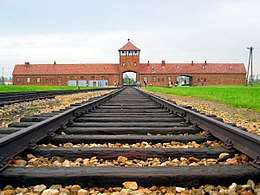Auschwitz Protocols
The Auschwitz Protocols, also known as the Auschwitz Reports, and originally published as The Extermination Camps of Auschwitz and Birkenau, is a collection of three eyewitness accounts from 1943–1944 about the mass murder that was taking place inside the Auschwitz concentration camp in German-occupied Poland during the Second World War.[1][2] The eyewitness accounts are individually known as the Vrba-Wetzler report, Polish Major's report, and Rosin-Mordowicz report.[3]

Description
The reports were compiled by prisoners who had escaped from the camp and presented in their order of importance from the Western Allies' perspective, rather than in chronological order.[3] The escapees who authored the reports were Rudolf Vrba and Alfred Wetzler (the Vrba-Wetzler report); Arnost Rosin and Czesław Mordowicz (the Rosin-Mordowicz report); and Jerzy Tabeau (the "Polish Major's report").[3]
The Vrba-Wetzler report was widely disseminated by the Bratislava Working Group in April 1944, and with help of the Romanian diplomat Florian Manoliu, the report or a summary reached—with much delay—George Mantello (Mandel), El Salvador Embassy First Secretary in Switzerland, via Swiss Vice-Consul Carl Lutz in Budapest.[4] Mantello immediately publicized it. This triggered large-scale demonstrations in Switzerland, sermons in Swiss churches about the tragic plight of Jews and a Swiss press campaign of about 400 headlines protesting the atrocities against Jews. The events in Switzerland and possibly other considerations led to threats of retribution against Hungary's Regent Miklós Horthy by President Roosevelt, Winston Churchill and others. This was one of the main factors which convinced Horthy to stop the Hungarian death camp transports.[5] The full reports were published by the United States War Refugee Board on 26 November 1944 under the title The Extermination Camps of Auschwitz (Oświęcim) and Birkenau in Upper Silesia.[1][6] They were submitted in evidence at the Nuremberg Trials as document number 022-L, and are held in the War Refugee Board archives in the Franklin D. Roosevelt Presidential Library and Museum in Hyde Park, New York.[6]
It is not known when they were first called the Auschwitz Protocols, but Randolph L. Braham may have been the first to do so. He used that term for the document in The Politics of Genocide: The Holocaust in Hungary (1981).[6]
Component reports
| Part of a series of articles on the Holocaust |
| Vrba-Wetzler report timeline |
|---|
 Main railroad track into Auschwitz II-Birkenau. |
|
Timeline 1942
1943
March 1944
April 1944
May 1944
June 1944
July 1944
|
|
Key figures
|
|
Historians
|
|
"Blood for goods"
|
|
Background
|
| Genocide portal |
- The Vrba-Wetzler report (the term "Auschwitz Protocols" is sometimes used to refer to just this report), a 33-page report written around 24 April 1944, after Vrba and Wetzler, two Slovak prisoners, who escaped from Auschwitz 7–11 April 1944.[7] In the Protocols, it was 33 pages long and was called "No 1. The Extermination Camps of Auschwitz (Oswiecim) and Birkenau in Upper Silesia."[8][9]
- The Rosin-Mordowicz report, a seven-page report from Arnost Rosin and Czesław Mordowicz, also Slovak prisoners, who escaped from Auschwitz on 27 May 1944.[7] This was presented as an additional chapter "III. Birkenau" to the Vrba-Wetzler report.[8]
- The "Polish Major's report," written by Jerzy Tabeau (or Tabau), who was in Auschwitz under the pseudonym Jerzy Wesołowski, and who escaped with Roman Cieliczko on 19 November 1943. Zoltán Tibori Szabó writes that Tabeau compiled his report between December 1943 and January 1944. It was copied using a stencil machine in Geneva in August 1944, and was distributed by the Polish government-in-exile and Jewish groups.[10] This was presented in the Protocols as the 19-page "No 2. Transport (The Polish Major's Report)."[8]
The contents of the Protocols was discussed in detail by The New York Times on 26 November 1944.[8]
See also
- Karski's reports
- Pilecki's Report
- Vrba–Wetzler report
- The Black Book of Poland
- The Polish White Book
- Raczyński's Note
- Witold's report, an earlier report on the same subject
- Jerzy Tabeau
- Witold Pilecki
References
Citations
- "The Extermination Camps of Auschwitz (Oświęcim) and Birkenau in Upper Silesia" (PDF). War Refugee Board. 26 November 1944. pp. 1–33. Also see "The Auschwitz Protocol: The Vrba–Wetzler Report" (PDF). Vrba–Wetzler Memorial. Archived from the original (PDF) on 27 July 2018.
- Tibori Szabó (2011), pp. 85–120
- Tibori Szabó (2011), p. 94
- Theo Tuschuy, "Dangerous Diplomacy: The Story of Carl Lutz, Rescuer of 62,000 Hungarian Jews, Ederman Publishing
- David Kranzler (2000). The Man Who Stopped the Trains to Auschwitz: George Mantello, El Salvador, and Switzerland's Finest Hour. Syracuse University Press. p. 87. ISBN 978-0-8156-2873-6.
- Conway (2002), pp. 292–293, footnote 3.
- Tibori Szabó (2011), p. 91
- Gilbert (1989), p. 305
- "The Auschwitz Protocol: The Vrba-Wetzler Report". Holocaust Research Project (Full text, online ed.).
- Tibori Szabó (2011), p. 90.
Sources
- Conway, John S. in Vrba, Rudolf (2002). Appendix I: The Significance of the Vrba-Wetzler Report on Auschwitz-Birkenau. I Escaped from Auschwitz. Barricade Books.CS1 maint: multiple names: authors list (link)
- Gilbert, Martin in Marrus, Michael Robert (1989). Part 9: The Question of Bombing Auschwitz. The Nazi Holocaust: The End of the Holocaust. Walter de Gruyter.CS1 maint: multiple names: authors list (link)
- Tibori Szabó, Zoltán in Braham, Randolph L. & vanden Heuvel, William (2011). "The Auschwitz Reports: Who Got Them, and When?". The Auschwitz Reports and the Holocaust in Hungary. Columbia University Press.CS1 maint: multiple names: authors list (link)
Further reading
- Braham, Randolph L. (1981). The Politics of Genocide: The Holocaust in Hungary (2011 ed.). Columbia University Press.
- Świebocki, Henryk (2013). "Informing the world about Auschwitz". Memorial and Museum Auschwitz-Birkenau.